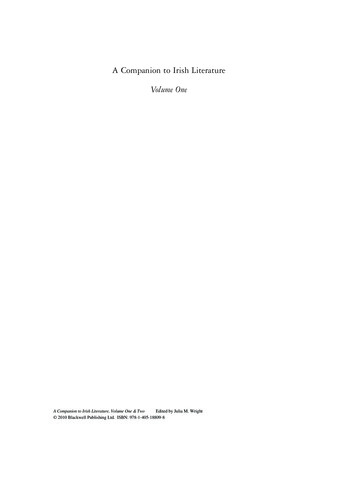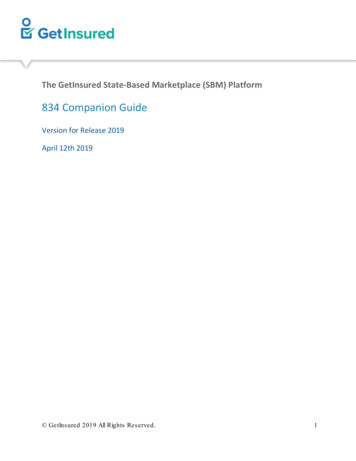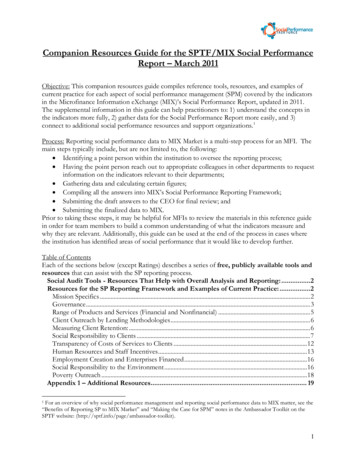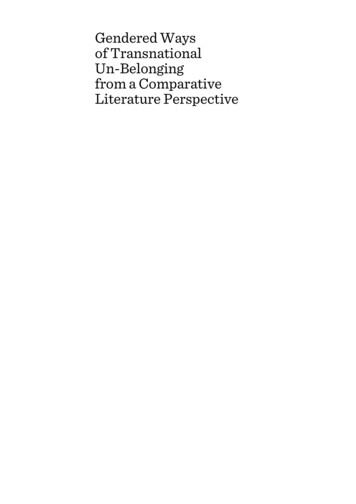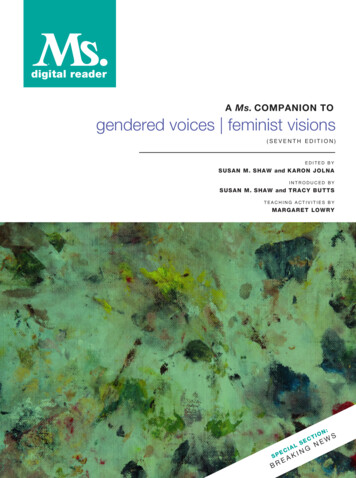
Transcription
digital readerA Ms. COMPANION TOgendered voices feminist visions(SEVENTH EDITION)EDITED BYSUSAN M. SHAW and KARON JOLNAINTRODUCED BYSUSAN M. SHAW and TRACY BUTTSTEACHING ACTIVITIES BYMARGARET LOWRYSPECBREL SIAIAKTECNGION:WNES
GENDERED VOICES FEMINIST VISIONSdigital readerContents1INTRODUCTIONS U S A N M . S H A W,Oregon State UniversityChapter 830Family Systems, Family LivesChapter 934Work Inside and Outside of the HomeChapter 12Women’s, Gender and Sexuality StudiesChapter 1038Resisting Gender ViolenceChapter 26Systems of Privilege and InequalityChapter 1142State, Law and Social PolicyChapter 310Learning GenderChapter 1246Religion and SpiritualityChapter 414Inscribing Gender on the BodyChapter 1350Activism, Change and Feminist FuturesChapter 518Media and CultureChapter 1454BREAKING NEWS58CONTRIBUTORSChapter 622Sex, Power and IntimacyChapter 726Health and Reproductive Justice
introductionBY SUSAN M. SHAWTO THE MS . COMPANION TO GENDEREDVoices, Feminist Visions: Classic and Contemporary Readings(7th edition)!Our textbook has been around a long time now, andwe’re so glad you’re using our new edition in yourwomen’s, gender and sexuality studies class. My Oregon State colleague Dr.Janet Lee and I wrote the book with students in mind, and so we’ve tried tomake it interesting, relevant, challenging and useful as a tool for learningabout gender and developing skills for feminist activism.Our new partnership with Ms. Classroom gives us the opportunity to provide you with up-to-the-moment readings that meld well with our textbook.The director of the Ms. Classroom program, Dr. Karon Jolna, and I have selected Ms. articles for you that we think address some of the important issuesof the current moment. We’ve also included a number of classic Ms. piecesfrom the magazine’s archives that grew directly out of the women’s movement, as well as some groundbreaking Ms. covers and iconic “No Comment” pages.My colleague Dr. Tracy Butts from California State University, Chico,and I have written brief introductions to each chapter highlighting some ofthe important issues related to the topics. We’ve followed the outline fromGendered Lives, Feminist Visions so you’ll be able to move easily from the textbook to the reader, making connections among the themes, ideas and questions raised by all the readings. Another colleague, Dr. Margaret Lowryfrom Texas Christian University, has written teaching activities for eachchapter to help you think more deeply about what you’re reading.You don’t have to be on social media or watch the news much at all to findexamples of current events that affect people differently based on gender,race, class, sexuality, ability, age, nationality and religion. Our entire 2019–2020 academic year was turned upside down by COVID-19, and then wesaw a resurgence of Black Lives Matter with the police killing of GeorgeFloyd and the widespread protests against racism and police brutality. We’vealso seen a president who tweets insults and falsehoods to stoke divisions,and we’re gearing up for a general election in the midst of all of these tensions and uncertainties.At this moment, we clearly need feminist lenses to help us think aboutwhat’s going on, how it’s affecting people differently and how we might actto bring about a better world. Our textbook and this companion reader arehere for you: to help you be better critical thinkers, to help you be informedand develop a critical feminist lens, and to help you go out and change theworld!WELCOMESUSAN M . SHAW,State Universitywww.msintheclassroom.comProfessor of Women’s, Gender, & Sexuality Studies Oregongendered vOiCeS feminiSt viSiOnS 1
1:Women’s, Gender and SexualityStudies: Perspectives and PracticeTHIS YOUR FIRST WOMEN ’ S , GENDER AND SEXUALITY STUDIEScourse? If so, you might notice a few things that are different from many ofyour other courses. First of all, women’s, gender and sexuality studies coursescenter the lives, voices and perspectives of groups of people you might notnormally learn about in traditional courses. Rather than assuming knowledgeis something objective to be discovered, women’s, gender and sexuality studiessees knowledge as something that is created by people who have their ownbiases and intentions that may be unrecognized. For example, many historybooks write history as a story of nations, wars and great men. What do youthink happens, though, if we writehistory from the perspective ofNative American women or blacklesbians? Those would be verydifferent history books. Inwomen’s, gender and sexualitystudies, we move the lives ofdiverse women to the center ofour research and theorizing tooffer different perspectives oneverything from history to scienceto pop culture. We also call this“decolonizing” knowledge. Thatmeans women’s, gender and sexuality studies challenges the dominance of traditional Westernknowledge and its claim to applyto everyone. Instead, women’s,gender and sexuality studiesengages the knowledges ofindigenous people, as well asscholarship from African, Asian,Wonder Woman for President, first issue, July 1972Latin American, women andLGBTQ thinkers.Second, women’s and gender studies courses use intersectionality as a keylens for analysis. Intersectionality looks at how various identities—gender,race, class, sexuality, ability, age, nationality and religion—shape one anotherwithin systems of power and across social institutions such as family, work,government and media. Rather than thinking of gender as something that exists apart from the other forms of difference, women’s, gender and sexualitystudies always keeps in mind the intersections of difference.Third, women’s, gender and sexuality studies is a transdisciplinary discipline.I know that may sound contradictory, but women’s, gender and sexuality studies draws from other academic fields like sociology, political science, anthroIS2 gendered vOiCeS feminiSt viSiOnSpology, literature, biology and publichealth to examine how gender (and itsintersections with other social identities) operates in the world.Fourth, women’s, gender and sexuality studies is activist and directed toward social justice. Women’s, genderand sexuality studies grew out of theactivist movements of the 1960s and’70s, and it continues to make connections between theory and practice,recognizing the ongoing need tomake change toward justice in theworld.Fifth, the women’s, gender and sexuality studies classroom uses feministpedagogies. Feminist pedagogies arefeminist theories of teaching andlearning that focus on making theclassroom a welcoming, inclusive andjust place where students are empowered through co-creating knowledgetogether with their professor. Ratherthan seeing students as empty vesselsto receive their knowledge, feministprofessors see students as their coteachers/learners in a shared enterprise. The feminist classroom valuesthe experiences of students as part ofthe learning process. The feministclassroom is also anti-racist, anti-classist, anti-ableist and anti-heterosexistas well as anti-sexist.You’ll see these differences in thetextbook Gendered Lives, Feminist Visions and this Ms. Companion to thetextbook. Take note of these differences as you read, participate in yourclass and do your class assignments.As you do, you’ll develop a new lensby which to see the world that hasbeen and is and to imagine the worldthat can be!www.msintheclassroom.com
GENDERED VOICES, FEMINIST VISIONSWOMEN’S, GENDER AND SEXUALITY STUDIES“Stay Home, Stay Healthy” is DangerousLanguageEmily Yate-Doerr“Stay home, stay healthy” reinforcesmisconceptions about how many people live—with the risk of doing more harm than good.Msmedia.org, April 3, 2020Celebrating FeminismJanell Hobsonfeminism has grown more popular, morerelevant and more vital than ever.Fall 2016This is What a Revolution Looks LikeJeanne K.C. Clarkin 50 years, the national Organization forWomen (nOW) has changed the lives of womeneverywhere.Summer 2016Virtual UMichelle Vlahoulis McGibbneyinteracting with online women’s studies courses.Spring 2015So You Want to Change the World?Michele Tracy BergerWomen’s studies is alive and well, taught inevery corner of the globe and spilling out ofclassrooms and into activism.Fall 2012www.msintheclassroom.comgendered vOiCeS feminiSt viSiOnS 3
GENDERED VOICES, FEMINIST VISIONSWOMEN’S, GENDER AND SEXUALITY STUDIESLearning Activities:“Stay Home, Stay Healthy” is Dangerous LanguageChapter 1 discusses the history and aims of the field ofwomen’s, gender, and sexuality studies and teaches that akey historical purpose of the field has been“to integrate a perspective that would challengepreviously unquestioned knowledge. This perspective questioned how such knowledge reflectswomen’s lives and concerns, how it maintainspatterns of male privilege and power, and howthe consequences of such knowledge affectwomen and other marginalized people.” (3)Emily Yates-Doerr’s article “‘Stay Home, Stay Healthy’Is Dangerous Language” provides an example of theways that women’s, gender, and sexuality studies “challenge[s] previously unquestioned knowledge.”Before you read the article, take a few moments to writedown the assumptions and values inherent in the phrase“Stay Home, Stay Healthy.” Who is telling people tostay home? What assumptions are made about what itmeans to be “home”? What assumptions are made aboutwhat it means to be “healthy”? Take a moment to compare your ideas with those of your peers. What ideas didyou come up with? Before this exercise, had you previously considered the assumptions that are inherent inthe phrase “Stay Home, Stay Healthy”?Next, read Yates-Doerr’s article. What concerns doesYates-Doerr raise about the phrase “Stay Home, StayHealthy?” Why does the phrase “risk doing more harmthan good” according to Yates-Doerr? How does thearticle provide an example of what it means to considerhow previously unquestioned knowledge “affects womenand other marginalized people”? Are there other recommendations regarding COVID-19 that you might wantto reconsider now that you’ve analyzed “Stay home, stayhealthy”? If so, what are they, and why do they deservecloser examination?4 gendered vOiCeS feminiSt viSiOnSCelebrating FeminismChapter 1 provides brief histories of the field ofwomen’s, gender, and sexuality studies and the U.S. feminist movement. Jeanne K.C. Clark’s article “This IsWhat a Revolution Looks Like” discusses the foundation of the National Organization for Women (NOW)in June 1966 and traces NOW’s involvement in the feminist movement from its founding to the present day. Indoing so, Clark recounts stories of feminist advocacy onmyriad issues and argues,“NOW and its allies have altered the face of this countryand the world. In law, politics, religion, marriage, family,employment, health, police, education, media,LQBTQA rights, government, economy, immigration,civil rights, sports, foreign relations and so much more,so much has changed” (35).Working alone or with a partner, choose 3-5 of the topics listed above. Read through the article and timeline tofind examples of changes that have occurred since 1966with regard to your selected topics. What do you learnabout how attitudes, norms, laws, and policies havechanged? What strategies did activists use to help enactthose changes? In what ways might you and your peersbe the beneficiaries of the feminist activism that Clarkdescribes? What changes have we seen since this articlewas published in 2016 that were catalyzed by feministactivism?www.msintheclassroom.com
www.msintheclassroom.comgendered vOiCeS feminiSt viSiOnS 5
2:Systems of Privilege and InequalityIN SPRING 2020 , K - 12 SCHOOLS AND UNIVERSITIES ACROSS THE U . S .transitioned to virtual modes of teaching and learning in an attempt to “flattenthe curve” and slow COVID-19’s rate of transmission. The sudden transitionto online instruction was intended to salvage the remainder of the term, preventing a disruption in students’ education and allowing continued progresstoward a degree. However, this move also inadvertently highlighted systems ofprivilege and inequality by exposing the persistent challenges faced by studentswho are economically disadvantaged, first-generation and/or members ofminoritized, marginalized or certain gendered groups. The popularity of the joke “we all go toZoom University now” attests tothe widespread use of the videoconferencing platform as the goto mode of virtual instruction. Yetthe use of Zoom further exacerbated existing concerns aboutaccess and equity, the digitaldivide, privacy and safety for someof our most vulnerable students.Even in the midst of a globalepidemic, there is an expectationthat students show up to class ontime, having done the readingsand assignments, and prepared togive their undivided attention tothe work at hand. Those studentswho had access to a personal computer; fast, reliable internet; andliving situations that affordedthem private spaces in which toBeginning Ms. Letter, Spring 2020study and Zoom were able tocomplete the semester with minimum disruption. But what about students who did not have access to these material resources and comforts? How might their failure to attend Zoomsessions or even appear on camera be read as a lack of interest or ability? Inwhat ways were systems of privilege and inequality created out of the differences between the haves and the have-nots?At the same time that institutions were beginning to grasp the enormity of6 gendered vOiCeS feminiSt viSiOnSthe access and equity issues, Zoombombing—the act of internet trollsand hackers hijacking a session byshouting or sharing racist, misogynistic and offensive messages—became aphenomenon, leaving students feelingunsafe and alienated in their academiccommunities. Zoombombing becamea reminder of the perils women face inonline environments, where the cloakof anonymity serves as a breedingground for racists, sexists, misogynistsand homophobes.Planning for the fall 2020 semesterand the likelihood that many institutions will be teaching largely online,faculty are considering the implications of their pedagogical approaches.While asynchronous class meetingsallow for greater flexibility, whichbenefits those students who work,commute and/or have family obligations, synchronous classes often provide structure and some form ofaccountability, which can prove useful to first-year and first-generationstudents who are making the transition from high school to college andlearning to navigate their waythrough higher education. Ultimately, the move to virtual instruction hasserved as a much-needed reminderfor us professors to consider our pedagogical practices, who gets includedor excluded based upon our decisionmaking, and the professional obligation we have to make sure that weteach to all of our students.www.msintheclassroom.com
GENDERED VOICES, FEMINIST VISIONSSYSTEMS OF PRIVILEGE AND INEQUALITYIn Solidarity (Ms. Letter)The Ms. Editors“this crisis has become a national teaching momentexposing some of the most glaring inequities in oursociety.”Spring 2020Five Lessons the AIDS EpidemicCan Teach Us About COVID-19Brad Sears“We can do what we can today to mitigate this crisis—but unless we continue to address the deepinequalities in our country, the groundwork for the nextepidemic, and the one after, has already been laid.Msmedia.org, March 17, 2020Black Girls MatterKimberle CrenshshawWhen national initiatives to help youth of color focusonly on boys, the needs of our most vulnerable youngwomen become invisible.Spring 2015Mericans (Ms. Fiction)Sandra CisnerosA snapshot in the life of children at the intersection ofreligion, gender, race, ethnicity, and nationality.Summer 2002Welfare Is A Women’s Issue (Ms. Classic)Johnnie Tillmoni’m a woman. i’m a black woman. i’m a poor woman.i’m a fat woman. And i’m on welfare. in this country, ifyou are any one of these things you count as less thana human being. if you are all of those things, you don’tcount at all. except as a statistic.Spring 2002www.msintheclassroom.comgendered vOiCeS feminiSt viSiOnS 7
GENDERED VOICES, FEMINIST VISIONSSYSTEMS OF PRIVILEGE AND INEQUALITYLearning Activities:In SolidarityChapter 2 focuses on gendered systems of privilege andinequality. These socially constructed systems are soingrained that they can be difficult to see and recognizeunless they are pointed out explicitly. In their letter “InSolidarity,” the Ms. editors point out the ways thatCOVID-19 reveals systems of privilege and oppressionin the U.S. They argue, “This crisis has become anational teaching moment, exposing some of the mostglaring inequities in our country.”What “glaring inequities” do the Ms. editors point out?How are those inequities gendered? How do they relateto the systems of privilege and inequality discussed inChapter 2? How do the Ms. editors argue for social justice in this text?8 gendered vOiCeS feminiSt viSiOnSwww.msintheclassroom.com
Black Girls MatterAs we learn in Ch. 2, systems of privilege and inequalityare created out of the differences among women. In“Black Girls Matter,” legal scholar, activist, and publicintellectual Kimberlé Crenshaw addresses the systemicways that black girls are disenfranchised within the education system—and even within reform efforts toaddress systemic challenges facing black youth.Take a look at the chart from “Black Girls Matter” p. 28(below). What do you learn about the ways that Blackgirls are treated in schools compared to white girls?How does the disparate treatment of Black girls andwhite girls compare to the disparate treatment betweenBlack boys and white boys? Are these statistics surprisingto you? Why or why not? How do these statistics combat commonplace ideas about the educational opportunities afforded to Black girls in comparison to other students?Crenshaw argues, “Feminists must speak out for a gender-inclusive racial justice agenda and must championefforts to bring a race-sensitive analysis to bear in advocating for women and girls of color” (29). How doeswww.msintheclassroom.com“Black Girls Matter” model the type of “race-sensitiveanalysis” that Crenshaw calls for?Dig deeper: Take a look at the “About” page on the website for the My Brother’s Keeper (MBK) Alliance( h t t p s : / / w w w. o b a m a . o r g / m b k a / a b o u t - m b k a / ) .According to the website, what is the need for an organization such as MBK? What are MBK’s aims? Now applyCrenshaw’s gender-inclusive lens to what you learnabout MBK. How does Crenshaw support her argumentthat organizations like MBK should provide explicit support for all Black children, rather than just supportingBlack boys?Next, take a look at pp. 9-12 of the white paper BlackGirls Matter: Pushed Out, Over-policed, and Underprotected. According to the authors, Black girls face specific issues within the education system related to theintersections of gender and race. What are the specificissues facing Black girls? How do the concerns raised in“Black Girls Matter” differ from the ones addressed onthe MBK website?gendered vOiCeS feminiSt viSiOnS 9
3:Learning GenderIS IT A BOY OR A GIRL ? THAT ’ S LIKELY THE FIRST QUESTION THAT WASever asked about you. When the person who delivers you answers that question, they set in motion a whole range of experiences that shape you from themoment you’re identified as a girl or a boy based on your anatomy. That is thegender assigned to you at birth. (And now, there’s a whole gender-reveal industry to answer that question even before a baby is born.)Typically, based on that assigned gender, you may be given a gendered name,dressed in different clothes (pink or blue), given different toys and handled differently by people who pick youup and hold you. You’ll get toldhow to act based on that gender:“Sit like a lady!” “Act like a man!”“Smile!” “Don’t cry!” Even now,you know exactly who those messages are for—which are for girlsand which are for boys. Gender isnot something we’re born with;it’s something we learn.Our dominant society onlygives us two choices, and mostpeople are comfortable enoughwith one of those. They learn toperform the gender that matchesthe one they were assigned atbirth, and their internal sense ofgender matches both the genderassigned at birth and the genderthey perform (gender expression). These people are called cisgender, and thedominant culture supports their gender identity. They can walk through theworld fairly easily without their gender being called into question or presenting obstacles for them.Not everyone, however, fits so easily into the gender they were assigned atbirth. Sometimes their gender identity does not match that gender. Somepeople may transition from the gender assigned at birth to their gender identity through their presentation (clothing, hairstyle, even the way they sit);some may take hormones and have gender affirmation surgeries so their bodies align with their gender identities. Transgender individuals often run intoproblems because of cisgender expectations. Recently, for example, we’ve seen10 gendered vOiCeS feminiSt viSiOnSpolitical efforts to force people to usebathrooms that match the gender assigned at birth rather than their gender identity.Not everyone who identifies as agender other than cisgender fits intothe gender binary (the belief in onlytwo separate genders). They mayidentify as gender nonbinary, gendernonconforming, genderqueer or awhole host of other identities, expressing themselves through a mix ofcharacteristics we typically classify asmale or female.In some way or another, we alllearn gender and express gender inthe ways we walk and talk and dressand interact with the world. Howabout you? How are you expressinggender right now? Have you ever resisted the ways society has imposedgender on you? For example, I alwayshated wearing dresses. I wanted toplay football. As I got older, I ran intogender expectations when people toldme I wasn’t supposed to do certainjobs because I was a woman (I didthem anyway). How does gendershape your life? How do you think thegender binary keeps people from doing some things they want to do?How can all of us resist the limitationsplaced on us because of gender? Whatdo the readings here and in the textbook suggest about how we learn andperform gender, how gender affectsus all, and how we can challenge theconstraints of gender?www.msintheclassroom.com
GENDERED VOICES, FEMINIST VISIONSLEARNING GENDERThinking Outside the Gender BoxKristi EatonSomali refugees combat gender norms andintimate partner violence.Spring 2020Toxic MasculinityStephanie Russell-Kraftin the minds of angry men’s rights supporters,it’s feminists who are always to blame.Spring 2019Three Chronicles (Ms. Fiction)Margaret Atwoodthree short stories examining gender roles andhow women and men fare in our fantastical andcomplex futures.Summer 2002 (1990)Baseball Diamond Are A Girl’s Best Friend(Ms. Classic)Letty Cottin PogrebinBoys have to worry about being good enoughto play. But girls have to worry about beingallowed to prove that they’re good.Spring 2002 (1974)Guide To Consciousness-Raising (Ms.Classic)Letty Cottin PogrebinConsciousness-raising groups bring womentogether to talk about their lives, creatingconnections between personal experience andbroader systems of privilege and oppression.Spring 2002 (1973)www.msintheclassroom.comgendered vOiCeS feminiSt viSiOnS 11
GENDERED VOICES, FEMINIST VISIONSLEARNING GENDERLearning Activities:Toxic MasculinityChapter 3 addresses cultural gender norms and expectations for masculinity and femininity and discusses theprivileges afforded to cisgender men who perform masculinity according to socially acceptable “regimes oftruth.”Women’s, gender, and sexuality studies scholars argue,“regimes” of truth that dictate “masculine” and “feminine” behavior are not “natural,” and many feministactivists work to dismantle gender norms that canbecome “a prison for both women and men” (105).As Stephanie Russell-Kraft discusses in her article“Toxic Masculinity,” some men’s rights groups appropriate and twist feminist gender analysis to argue, “malepower and male oppression of women is a myth” (qtd inRussell-Kraft 33.)Take a look at the images to the right. The top image isfrom the University of Wisconsin—Madison Police’santi-sexual assault campaign.Who is the audience for this ad? What is the messagebeing communicated? What gender norms underlie theargument being made? Why might anti-rape activistsconsider this ad to be problematic? Why might men’srights groups like the ones described in “ToxicMasculinity” be angered by this ad?Next, take a look at the ad that a men’s rights group ran inresponse to the “Don’t Be That Guy” campaign (center).Who is the audience for this ad? What is the messagebeing communicated? What gender norms underlie theassumptions being made? Why is this ad problematic?What do you learn about men’s rights groups’ attitudesabout feminism when you compare these ads side by side?Finally, take a look at the bottom image, which is featured on the website for the National Organization ofMen Against Sexism (NOMAS), an organization discussed on p. 104 of your textbook.12 gendered vOiCeS feminiSt viSiOnSWhat is the effect of the update on the iconic image ofRosie the Riveter? What messages are being communicated? How does this image challenge “regimes of truth”associated with masculinity and femininity? How does italign with—rather than challenge and co-opt—feministvalues?www.msintheclassroom.com
Guide to Consciousness-RaisingIn Chapter 3, we learn, “gender is so central in shapingour lives, much of what is gendered we do not even recognize; it’s made normal and ordinary and occurs on asubconscious level” (98). Letty Cottin Pogrebin’s“Guide for Consciousness-Raising” describes one strategy for making the unconscious conscious—and creatinga strong support community in the process.Although Cottin Pogrebin’s “Guide” could be considered old-fashioned (this Ms. Classic article was originallypublished in 1972!), the act of gathering for consciousness-raising sessions is as radical today as it was then,particularly given our 21st-C impulse to focus moreintently on our electronics than on each other. AndCottin Pogrebin’s framing questions provide an interesting starting point for discussions about gender normsthat we often take for granted.Working with a partner or in a small group, talk throughthese questions, which Cottin Pogrebin poses in her“Guide to Consciousness Raising”: Who do you live with, and how do you like it? Who do you usually confide in? Do you feel like a grown-up?Next, reflect on your conversation. Are there things thatbecome apparent about gender roles as you talk throughthese questions? How might participation in ongoingconsciousness-raising groups benefit college students?www.msintheclassroom.comgendered vOiCeS feminiSt viSiOnS 13
4:Inscribing Gender on the BodyWHEN I WAS A CHILD , MY MATERNAL GRANDMOTHER INSISTED THAT MYcousins and I had black dolls so that that we would grow up surrounded bypositive, affirming images of blackness. As a black woman, I am unapologetically proud of my blackness. Yet as a black woman inhabiting a larger body, Iam all too aware of the manner in which my body is measured, compared toothers, held to a one-size-fits-all standard of beauty—and found to be lacking.When I was growing up in the ’70s, there was a lack of representation of blackness in popular culture and media, but that lack paled in comparison to thedearth of examples of plus-sized women, who were often portrayed as thefunny, sassy best friend but neverthe leading lady nor the loveinterest. Even as a young person,it was clear to me that certainbodies, particularly certain femalebodies, were preferable, desirable.Discourses or regimes of truthabout fat bodies insist that they becovered from head to toe and takeup as little space as humanly possible. Fat women are expected to beembarrassed of their bodies andare often shamed for daring toembrace their curves. In December 2019, American-born singerLizzo attended a Los AngelesLakers basketball game. Duringthe cheerleaders’ halftime performance, they danced to her song“Juice,” and Lizzo, clad in abooty-bearing dress that revealedher thong, gave an impromptutwerk performance from herSummer 2008: Body imagecourtside seat.The backlash was immediate,with Lakers fans calling for the performer to be banned from future games. Although critics cited concerns about propriety and modesty, young children being exposed to a scantily clad woman and the singer’s health due to her weight,it was evident that the real issue was Lizzo’s unapologetic display of her body.She dared to act in the same manner as her “normal”-weight celebrity peers. Inresponse to critics’ attempts to fat-shame her, the singer posted a video to TikTok sharing her workout regimen. The video, which sought to debunk stereo-14 gendered vOiCeS feminiSt viSiOnStypical notions that fat is synonymouswith laziness and slovenliness, endswith Lizzo asserting, “I’m not working out to have your ideal body type.I’m working out to have my idealbodytype”—underscoringthesinger’s desire to exercise autonomyover her own body.In May 2020, British-born singerAdele made the news after unveilingher dramatic weight loss. Like Lizzo,Adele also sought to exercise bodilyautonomy. Fans and tabloids took tosocial media to gleefully exclaim howbeautiful the singer had become. Others shared that they felt betrayed bythe formerly fat entertainer, whomthey saw as a plus-sized role model.As Lizzo’s and Adele’s experiencesdemonstrate, women’s bodies areviewed as communal property, witheveryone invited to have an opinionand weigh in on their suitability.When society obsesses about Lizzo’sand Adele’s weight, conversationsabout the singers’ bodies overshadowtalk of their performances and musicaltalents, the activities their bodies areactually responsible for. Our treatment of the singers brings to mind apassage in Zora Neale
Gendered Lives, Feminist Visionsso you’ll be able to move easily from the text-book to the reader, making connections among the themes, ideas and ques-tions raised by all the readings. Another colleague, Dr. Margaret Lowry from Texas Chris

